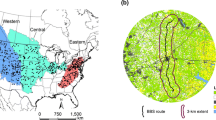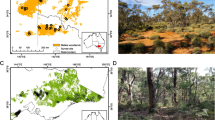Abstract
We suggest that the life histories of species within communities may differ among geographic locations and that communities from distinct biomes may respond uniquely to a given trajectory of landscape change. This paper presents initial tests relevant to these hypotheses. First, the representation of various life-history guilds in avifaunas from the Eastern Deciduous (EDF) and Pacific Northwest (PNW) forests were compared. Three guilds contained more species in the EDF community (large patch and/or habitat interior guild, small patch and/or edge guild, and fragmentation-sensitive guild). The guild of predators requiring large forest tracts was better represented in the PNW. Next, the relative sensitivity of each community to habitat change was ranked based on the life-history traits of their species. The EDF avifauna had a significantly higher index of sensitivity to both forest fragmentation and to landscape change in general. Among the birds with high scores for sensitivity to landscape change were several species that have received little conservation attention thus far including some associated with open-canopy habitats. Lastly, the validity of using life histories to predict community response to landscape change was supported by the fact that the sensitivity scores for PNW species correlated significantly with independent data on species population trends. While more rigorous analyses are suggested, we conclude that knowledge of life histories is useful for predicting community response to landscape change and that conservation strategies should be uniquely tailored to local communities.
Similar content being viewed by others
References
Ambuel, B. and Temple, S.A. 1983. Area-dependent changes in bird communities and vegetation of southern Wisconsin forests. Ecology 64: 1057–1068.
Begon, M., Harper, J.L. and Townsend, C.R. 1986. Ecology: Individuals, populations, and communities. Sinauer Associates, Inc., Sunderland, MA, USA.
Brittingham, M. and Temple, S.A. 1983. Have cowbirds caused forest songbirds to decline? BioScience 33: 31–35.
Brown, E.R., Technical Editor. 1985. Management of wildlife and fish habitats in forests of western Oregon and Washington. USDA Forest Service R6-F&WL-192-1985, Portland, OR, USA.
Chasko, G.C. and Gates, J.E. 1982. Avian habitat suitability along a transmission-line corridor in an oak-hickory forest region. Wildlife Monographs 82: 1–41.
Dawson, W.R., Ligon, J.D., Murphy, J.R., Myers, J.P., Simberloff, D. and Verner, J. 1986. Report of the Advisory Panel on the Spotted Owl. Audubon Conservation Report 7. National Audubon Society, New York, NY, USA.
Ehrlich, P.R., Dobkin, D.S. and Wheye, D. 1988. The Birder's Handbook. Simon & Schuster, Inc., New York, NY, USA.
Forman, R.T.T., Galli, A.E. and Leck, C.F. 1976. Forest size and avian diversity in New Jersey woodlots with some land use implications. Oecologia 26: 1–8.
Franklin, J.F., Spies, T., Perry, D., Harmon, M. and McKee, A. 1986. Modifying Douglas-fir Management Regimes for Nontimber Objectives. In Proceedings of a Symposium Modifying Douglas-fir Management Regimes for Nontimber Objectives, Seattle, WA, 18–20 June 1985. pp. 373–379. Edited by C.D. Oliver, D.P. Hanley and J.A. Johnson. USDA Forest Service, Seattle, WA, USA.
Franklin, J.F. and Forman, R.T.T. 1987. Creating landscape patterns by forest cutting: ecological consequences and principles. Landscape Ecology 1(1): 5–18.
Franklin, J.F. 1988. Pacific Northwest forests. In North American Terrestrial Vegetation. pp. 104–127. Edited by M.G. Barbour and W.D. Billings. Cambridge University Press, New York, NY, USA.
Freemark, K.E. and Merriam, H.G. 1986. Importance of area and habitat heterogeneity to bird assemblages in temperate forest fragments. Biological Conservation 36: 115–141.
Galli, A.E., Leck, C.F. and Forman, R.T.T. 1976. Avian distribution patterns in forest islands of different sizes in central New Jersey. Auk 93: 356–364.
Gates, J.E. and Gysel, L.W. 1978. Avian nest dispersion and fledgling success in field-forest ecotones. Ecology 59: 871–883.
Hansen, A.J., Spies, T.A., Swanson, F.J. and Ohmann, J.L. 1991. Conserving biodiversity in managed forests: Lessons from natural forests. BioScience 41(6): 382–392.
Hansen, A.J., Urban, D.L. and Marks, B. 1992. Avian community dynamics: The interplay of landscape trajectories and species life histories. In Landscape Boundaries: Consequences for Biodiversity and Ecological Flows. pp. 170–195. Edited by A.J. Hansen and F. di Castri. Springer Verlag, New York, NY, USA.
Harris, L.D. 1984. The Fragmented Forest. University of Chicago Press, Chicago, IL, USA.
Harris, L.D. 1988. Edge effects and conservation of biotic diversity. Conservation Biology 2(4): 330–332.
Jennersten, O. 1988. Pollination in dianthus-deltoides caryophyllaceae effects of habitat fragmentation on visitation and seed set. Conservation Biology 2(4): 359–366.
Klein, B.C. 1989. Effects of forest fragmentation on dung and carrion beetle communities in central Amazonia Brazil. Ecology 70(6): 1715–1725.
Kroodsma, R.L. 1982. Edge effect on breeding forest birds along a power-line corridor. Journal of Applied Ecology 19: 361–370.
Lande, R. 1982. A quantitative genetic theory of life history evolution. Ecology 63(3): 607–615.
Lehmkuhl, J.F., Ruggiero, L.F. and Hall, P.A. 1991. Landscape-level patterns of wildlife richness and abundance in the Pacific Northwest. In Wildlife and Vegetation of Unmanaged Douglas-fir Forests. pp. 425–442. L.F. Ruggiero, K.B. Aubry, A.B. Carey and M.H. Huff, technical coordinators. USDA Forest Service General Technical Report PNW-GTR-285, Portland, OR.
Love, T. 1990. Distribution maps of Pacific Northwest birds using neotropical habitats. Oregon Birds 16(1): 56–85.
Lynch, J.F. and Whitcomb, R.F. 1978. Effects of the insularization of the eastern deciduous forest on avifaunal diversity and turnover. In Classification, Inventory, and Analysis of Fish and Wildlife Habitat. pp. 461–489. Edited by A. Marmelstein. USDI Fish and Wildlife Service, Washington, D.C., USA.
MacClintock, P., Whitcomb, R.F. and Whitcomb, B.L. 1977. Island biogeography and ‘habitat islands’ of eastern forest. II. Evidence for the value of corridors and minimization of isolation in preservation of biotic diversity. American Birds 31: 6–16.
Merriam, G. and Wegner, J. 1992. Local extinctions, habitat fragmentation and ecotones. In Landscape Boundaries: Consequences for Biodiversity and Ecological Flows. pp. 150–169. Edited by A.J. Hansen and F. di Castri. Springer Verlag, New York, NY, USA.
Noss, R.F. 1983. A regional landscape approach to maintain diversity. BioScience 33: 700–706.
Noss, R.F. 1991. Effects of edge and internal patchiness on avian habitat-use in an old-growth Florida hammock. Natural Areas Journal 11(1): 34–47.
Pianka, E.R. 1970. On r- and k-selection. American Naturalist 104: 592–597.
Ranney, J.W., Bruner, M.C. and Levenson, J.B. 1981. The importance of edge in the structure and dynamics of forest islands. In Forest Island Dynamics in Man-dominated Landscapes. pp. 67–96. Edited by R.L. Burgess and D.M. Sharpe. Springer-Verlag, New York, NY, USA.
Ripple, W.L., Bradshaw, G.A. and Spies, T.A. 1991. Measuring forest fragmentation in the Cascade Range of Oregon. Biological Conservation 57(1): 73–88.
Robbins, C.S., Dawson, D.K. and Dowell, B.A. 1989. Habitat area requirements of breeding forest birds of the middle Atlantic states. Wildlife Monographs 103: 1–34.
Rosenberg, K.V. and Raphael, M.G. 1986. Effects of forest fragmentation on vertebrates in Douglas-fir forests. In Wildlife 2000. pp. 263–272. Edited by J. Verner, M.L. Morrison and C.J. Ralph. The University of Wisconsin Press, Madison, WI, USA.
Roth, R.R. 1976. Spatial heterogeneity and bird species diversity. Ecology 57: 773–782.
Ryszkowski, L. 1992. Energy and material flows across boundaries in agricultural landscapes. In Landscape Boundaries: Consequences for Biodiversity and Ecological Flows. pp. 270–284. Edited by A.J. Hansen and F. di Castri. Springer Verlag, New York, NY, USA.
Sharp, B. 1990. Population trends of Oregon's neotropical migrants. Oregon Birds 16(1): 27–42.
Small, M.F. and Hunter, M.L. 1988. Forest fragmentation and avian nest predation in forested landscapes. Oecologia 76: 62–64.
Stearns, S.C. 1977. The evolution of life history traits: a critique of the theory and a review of the data. Annual Review of Ecology and Systematics 8: 145–171.
Terborgh, J. 1989. Where Have all the Birds Gone? Princeton University Press, Princeton, NJ, USA.
Thomas, J.W., Forsman, E.D., Lint, J.B., Meslow, E.C., Noon, B.R. and Verner, J. 1990. A conservation strategy for the Northern Spotted Owl. USDA Forest Service, USDI Bureau of Land Management, USDI Fish and Wildlife Service, and USDI National Park Service, Portland, OR, USA.
Urban, D.L., Shugart, H.H. Jr., DeAngelis, D.L. and O'Neill, R.V. 1988. Forest bird demography in a landscape mosaic. Oak Ridge National Laboratory Publication No. 2853, Oak Ridge, TN, USA.
Waring, R.H. and Franklin, J.F. 1979. Evergreen coniferous forests of the Pacific Northwest. Science 204: 1380–1386.
Whitcomb, B.L., Whitcomb, R.F. and Bystrak, D. 1977. Island biogeography and ‘habitat islands’ of eastern forest. III. Long-term turnover and effects of selective logging on the avifauna of forest fragments. American Birds 31: 17–23.
Whitcomb, R.F., Robbins, C.S., Lynch, J.F., Whitcomb, B.L., Klimkiewicz, K. and Bystrak, D. 1981. Effects of forest fragmentation on avifauna of the eastern deciduous forest. In Forest island dynamics in man-dominated landscapes. pp. 125–205. Edited by R.L. Burgess and D.M. Sharpe. Springer-Verlag, New York, NY, USA.
Wilcove, D.S. 1985. Nest predation in forest tracts and the decline of migratory songbirds. Ecology 66: 1211–1214.
Zarnowitz, J.E. and Manuwal, D.A. 1985. The effects of forest management on cavity-nesting birds in northwestern Washington. Journal of Wildlife Management 49(1): 255–263.
Author information
Authors and Affiliations
Rights and permissions
About this article
Cite this article
Hansen, A.J., Urban, D.L. Avian response to landscape pattern: The role of species' life histories. Landscape Ecol 7, 163–180 (1992). https://doi.org/10.1007/BF00133308
Issue Date:
DOI: https://doi.org/10.1007/BF00133308




